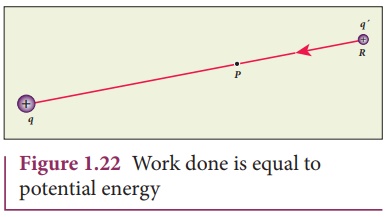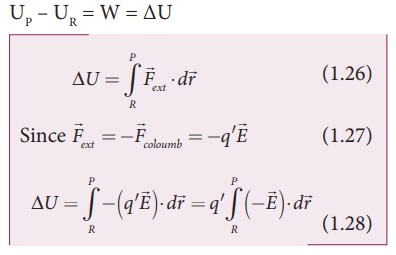Chapter: 12th Physics : Electrostatics
Electrostatic Potential energy and Electrostatic potential
ELECTROSTATIC POTENTIAL AND POTENTIAL ENERGY
Introduction
In mechanics, potential
energy is defined for conservative forces. Since gravitational force is a
conservative force, its gravitational potential energy is defined in XI
standard physics (Unit 6). Since Coulomb force is an inverse-square-law force,
its also a conservative force like gravitational force. Therefore, we can
define potential energy for charge configurations.
Electrostatic Potential energy and Electrostatic
potential
Consider a positive
charge q kept fixed at the origin which produces an electric field ![]() around it. A positive test charge q′
is brought from point R to point P against the repulsive force between q and q′ as shown in Figure
1.22. Work must be done to overcome this repulsion. This work done is stored as
potential energy.
around it. A positive test charge q′
is brought from point R to point P against the repulsive force between q and q′ as shown in Figure
1.22. Work must be done to overcome this repulsion. This work done is stored as
potential energy.

The test charge q′ is brought from R to P with
constant velocity which means that external force used to bring the test charge
q′ from R to P must be
equal and opposite to the coulomb force  .
The work done is
.
The work done is

Since coulomb force is
conservative, work done is independent of the path and it depends only on the
initial and final positions of the test charge. If potential energy associated
with q′ at P is UP
and that at R is UR, then difference in potential energy is defined
as the work done to bring a test charge q′
from point R to P and is given as UP – UR = W = ΔU

The potential energy
difference per unit charge is given by

The above equation
(1.29) is independent of q′.
The quantity  is called electric
potential difference between P and R and is denoted as VP – VR
= ∆V.
is called electric
potential difference between P and R and is denoted as VP – VR
= ∆V.
In otherwords, the
electric potential difference is defined as the work done by an external force
to bring unit positive charge from point R to point P.

The electric potential
energy difference can be written as ∆U = q′
∆V. Physically potential difference between two points is a meaningful
quantity. The value of the potential itself at one point is not meaningful.
Therefore the point R is taken at infinity and its potential is considered as
zero (V∞ = 0).
Then the electric potential at a point P is
equal to the work done by an external force to bring a unit positive charge
with constant velocity from infinity to the point P in the region of the
external electric field ![]() .
.
Mathematically this is
written as

Important points
1. Electric potential at
point P depends only on the electric field which is due to the source charge q
and not on the test charge q′.
Unit positive charge is brought from infinity to the point P with constant
velocity because external agency should not impart any kinetic energy to the
test charge.
2. From equation (1.29),
the unit of electric potential is Joule per coulomb. The practical unit is volt
(V) named after Alessandro Volta (1745-1827) who invented the electrical
battery. The potential difference between two points is expressed in terms of
voltage.
Related Topics